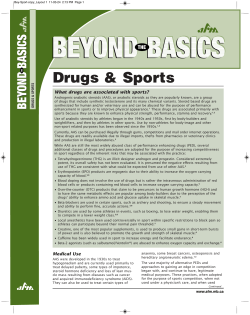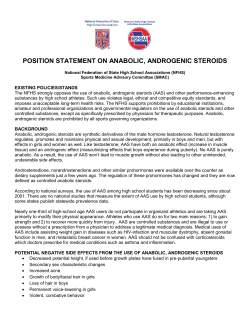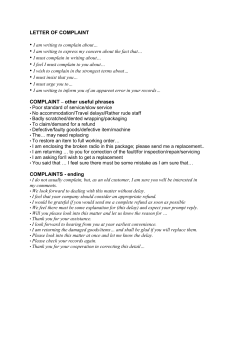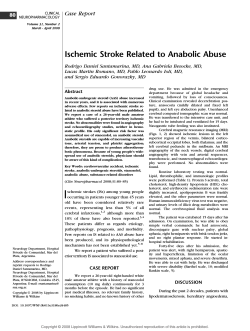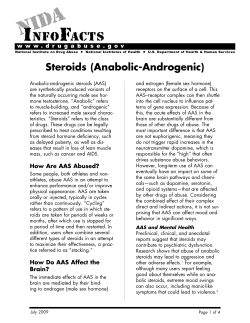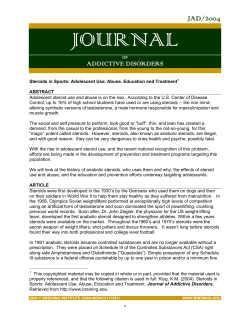
” ⊙ Prohibited Substances [1] Anabolic-Androgenic Steroids
【 “Side Effects” of “Doping drugs” 】
By : Prof. Keun-Youl
KIM, M.D. (OCA-MC & Chair of OCA-TUE Subcomm.)
( Handout for Education Symposium – Macau. October 2005)
⊙ Prohibited Substances
[1] Anabolic-Androgenic Steroids
* Widely abused drug. Estimated 1-3 million athletes in US alone have
used anabolic steroids, with annual black market sales well in excess of
$100 million. (Silver M. 2001) (Buckley WE et al. 1988) (Haipt HA et al,1984)
* Among American adolescents, use rate generally range between 4-12%
among young men and are as high as 2% among young women.(Bahrke,1998)
* Recently, there has been increasing concern over so-called “ designer
steroids “. Most popular of these is “ tetrahydrogestrinone (THG) “.
(Tokish JM et al. 2004)
≪ SIDE EFFECTS ≫
* Studying the side effects and health risks of anabolic steroid use is difficult. Because the drugs are illegal & there is paucity of well-controlled
studies available for review.
Nevertheless, a number of studies have investigated the health
consequences associated with these drugs and have provided strong
evidence of their risks, including hepatic cellular damage, testicular
atrophy, cardiovascular disease, and psychological disturbance, musculoSkeletal effects and even increased mortality.
(1) Cardiovascular effects:
(a) Elevated blood pressure, decreased high-density lipoprotein,
Erythrocytosis, Myocardial hypertrophy, Arrhythmia, Thrombosis.
(b) Association between Endothelial dysfunction with an atherogenic
blood lipid profile, and may pose an increased risk of atherosclerosis.
(Ebenbichler CF et al, 2001)
(c) Decrease (25% - 27%) in HDL cholesterol & increase in diastolic
blood pressure after 8 weeks of anabolic steroid use. (Kuipers,1991)
(d) Associated with hypertension, myocardial ischemia, and sudden
cardiac death.
( Fieschi V et al. 2001)(Sillivan ML et al.1998)(Parssinen M et al. 2002)
( Wight JN et al. 1995) (Meichert RB et al: 1995)
(2) Hepatic effects (functional / structural)
(a) Hepatotoxicity (elevated liver function tests) / jaundice
(b) Neoplasm
(3) Reproductive- Endocrine effects
(a) Libido changes, Subfertility, Decreased Luteinizing hormone and
follicle-stimulating hormone.
(b) Increased aggressiveness and sexual appetite, sometimes resulting
in aberrant sexual and criminal behavior.
(c) In Males Only : Impotence with chronic or repeated use, testicular
shrinkage(atrophy), breast enlargement (gynecomastia), prostatic
enlargement, reduction of sperm production, premature baldness.
(d) In Female Only : Masculinization/Hirsutism, excessive hair growth on
the face & body, deepening of the voice, enlargement of clitoris,
abnormal menstrual cycles (suppression of ovarian function and
menstruation), reduced breast size. Polycystic ovarian syndrome.
(e) Childrn: Premature epiphyseal closure of the growth center of long
bones (in adolescents) which may result stunted growth.
Premature puberty among female child.
(4) Psychological effects / Behavioral effects
(a)
Mood swings, Aggression, Mania, Depression, Withdrawal,
Dependence.
(b) Direct cause of significant disturbances in personality profiles.
(Cooper CJ et al, 1996)
(c) Significantly less in control of their aggression than did controls.
(Midgley et al, 2001)
(5) Dermatologic effects
(a) Acne, Striae, Alopecia
(b) Gynecomastia
(c) Hursutism (male pilosis)(Too many body-hari as male)
(d) Collagen reducing skin elasticity
(6) Musculo-skeletal system effects:
(a) Muscle tightness and cramp.
(b) Stiff tender, resulting in an increased potential for muscle strains or
rupture.
(7) Mortality rates:
(a) The most severe consequences of long-term AAS use many be on the
cardiovascular system. (Parssinen M, 2002)
(b) Mortality rates among elite power lifters during the years of follow
up was 12.9% in the body-builders compared with 3.1 % in the controll population. The causes of death among the power lifters
include suicide, acute myocardial infarction, hepatic coma, nonHodgkin’s lymphoma. ( Parssinen M et al, 2000)
(c) Investigation on cause of death of steroid abusers among the demise
of 34 known users of anabolic steroid, investigator found: 9; victim of
homicide, 11; committed suicide, 12; judged accidental, 2; not determmined. And concluded that anabolic steroid use was associated with
increased risk of violent death from impulsive, aggressive behavior or
depressive symptoms. Chronic cardiac changes were observed in 12
cases (35%)
(8) Injection associated with needle sharing:
(Rich JD et al,1999)
(a) Bruising, Infection, Fibrosis, Neuro-vascular injury.
(b) Risk of acquirig AIDS, hepatitis(B,C), and other blood-borne diseases,
abscesses increase greatly with the use of injectable forms.
(c) 25% rate of needle sharing among adolescent anabolic steroid users.
★ (9) Other anabolic agents, including but not limited to:
Clenbuterol, tibolone, Zeranol, zilpaterol.
(Kim KY,2000)
(Beta-2 Agonist < Clenbuterol, Bambuterol, Salbutamol, Salmeterol,
Formoterol, Terbutaline, Reproterol etc >
: permitted only by inhalation : Formoterol, Salbutamol, Salmeterol
Terbutaline. )
(a) Headache, insomnia, nausea, nervousness, tremor, muscle cramps
(b) Increased heart rate and blood pressure
(c) Withdrawal symptoms, physiologic dependence, habituation.
(d) Tachyphylaxis (become refractory to the protective effects)
(Cheung D.et al. 1992. Ramage L, et al: 1994. Chong et al,1995)
(e) Association with an increased risk of the combined outcome of
fatal and near-fatal asthma, as well as of death from asthma alone.
(Spitzer WO et al. 1992. Sears MR et al. 1990)
(10) Long-Term Health Risks
(a) The health risks associated with long-term therapeutic doses of
testosterone and chronic supraphysiologic doses of AAS are unknown.
(b) The most severe consequences of long-term AAS use many be on the
cardiovascular system. ( Parssinen M et al, 2002)
* Left ventricular hypertrophy, Impaired diastolic filling, Arrhythmia,
* Increased risk of myocardial infarction and sudden death.
(Melchert RB, Welder AA, 1995) (Wight JN, Salem D., 1995)
(c) As etiologic factors for some cancers. (Parssinen M et al, 2002)
* Hepatic tumor (Nako A. et al.: 2000)
* Renal cell carcinoma (Bryden AAG, 1995) (Martorana G et al,1999)
* Testicular tumor (Froehner M et al, 1999)
* Prostatic cancer (Heikkila R et al, 1999)
(d) The risk of mortality among chronic AAS users is reported to be 4.6
times higher than non-AAS users. (Parssinen M et al, 2000)
≪ Physical Signs of Anabolic-Androgenic Steroid Use ≫
(Evans NA, 2004)
1. Appearance : Muscular hypertrophy,
Hirsutism and voice deepening (female)
2. Skin
: Acne
Cutaneous striae in delto-pectoral region
Needle marks in buttocks, thigh, deltoids, baldness.
3. Chest
: Gynecomastia (males)
Breast tissue atrophy (females)
4. Genitourinary : Testicular atrophy (male)
Clitoral hypertrophy (females)
[2] Stimulants
(1)
(2)
(3)
(4)
(5)
Increased heart rate, palpitation, cardiac irregularities
Insomnia, Anxiety, Tremor, Aggressiveness.
Inhibited judgement / decision making.
Increased potential for dehydration.
Amphetamines: Anxiety, ventricular dysrhythmias, hypertension,
hallucinations, addiction, death
(6) Ephedrine: Anxiety, ventricular dysrhythmias, hypertension,
hallucinations, addiction.
[3] Narcotics
(1)
(2)
(3)
(4)
(5)
Increased pain threshold and failure to recognize injury.
Loss of balance and coordination.
Illusion of athletic prowess beyond inherent ability.
A false feeling of invincibility
Sedation
[4] Peptide Hormones
{1} Erythropoietin (EPO)
(1) Thickening of the blood clots (increases blood viscosity)
(2) Increased the risk of heart attacks, myocardial infarction and
strokes, pulmonary embolism.
{2} Growth Hormone (GH)
(1)
(2)
(3)
(4)
(5)
Overgrowth of hand, feet and face (Acromegaly)
Heart diseases, myopathic muscle
May develop resistance to long-term use
Carpal tunnel syndrome
Increased oil gland production in the skin & increased sweating.
{3} Insulin-like Growth Factor (IGF-1)
(1) Hypoglycemia
(2) Musculoskeletal changes such as enlargement of the heart,
headaches and joint pains. Muscles may at first becomes
stronger, but ultimately are weakened due to degenerative
changes in the joints.
{4} Insulin
(1) Hypoglycemia (low blood sugar)
(2) Nausea, weakness, shortness of breath
(3) Drowsiness, coma, brain damages and death.
{5} Chorionic Gonadotrophins (HCG)
(Stimulate Testosterone production in male)
(1) Same effects as Anabolic steroids
(2) Gynecomastia may be more common.
{6} Corticotrophins (ACTH)
(1)
(2)
(3)
(4)
Stomach irritation & ulcer
Softening of connective tissue
Osteoporosis
Cataracts.
⊙ Prohibited Methods
[1] Blood Doping
(1) Allergic reaction (rash, fever, shock, etc)
(2) Acute hemolytic reactions with kidney damage if incorrectly typed
blood is used.
(3) Delayed transfusion reactions resulting in fever and jaundice.
(can be fatal)
(4) Transmission of infectious diseases (viral hepatitis and AIDS)
(5) Overload of the circulatory system & blood clots
(6) Metabolic shock.
[2] Artificial Oxygen Carriers and Plasma Expanders
(1) Vary significantly and can be extreamly serious, as it is difficult
to measure correct doses.
(2) These include fever, reduced platelet count, hypertension,
Vasoconstriction, kidney damage and iron overload.
[3] Gene Doping
(1) Gene therapy can be used theoretically to build muscle, to alter and
adjust muscle composition.
(2) SIDE REACTION:
* Gene therapy is far from mastered, and the chance of success are
very low and the risks are still very high.
* Gene therapy can be quite dangerous.
(Prof. T. Friedmann, 2005. WADA, Play true. Gene Doping).
* Nevertheless, most experts predict that rogue labs will pop up
in the US, and elsewhere around the world, which willing to
make experimental gene doping, no matter how dangerous,
available to athletes for the right price.
⊙ Food (Nutritional) Supplements
* The field of nutritional supplementation for ergogenic benefit is complex,
constantly changing, and poorly studied. (Schwenk TL et al: 2002)
* A metaanalysis of supplement use, pooling 51 studies involving 10,274
athletes at all level and participating in 15 sports, showed an overall
prevalence of supplement use of 46%, with most studies showing a pre-
valence of greater than 50%, although larger studies found a prevalence
of less than 50%. (Sobal J et al, 1994)
* Very few studies have examined the benefits to performance of longterm, nonanabolic supplement use.
[1] Copper
(1) Primary benefit is antioxidant protection.
(2) Excessive supplementation can cause gastrointestinal distress,
nausea, vomiting, diarrhea, intravascular hemolysis.
(Lukaski HC,1995)
[2] Zinc (also called “the well-being mineral”)
(1) Supplements of 25-50 mg/day may interfere with the absorption of
iron and copper. (Schwenk TL, 2002)
(2) Higher dose may cause nausea and vomiting.
[3] Magnesium
(1) Excessive intake led to gastrointestinal upset, nausea, vomiting and
diarrhea.
(2) Interference with the absorption of calcium.
[4] B-complex and Multivitamins
(1) Vitamin A, D, B3, and B6 can be toxic at excessive doses.
(2) McDonald R et al, 1988 / Bucci L, 1993)
[5] Vitamin C
(1) Primary adverse effect is its competition for copper bioavailability
(2) Risk of Renal calculi due to urine acidification.
[6] Calcium
(1) Calcium interferes with the absorption of Zinc and Iron.
(2) Can result in the development of renal calculi at high dose.
[7] Iron
(1) Excessive Iron intake may lead to hepatic damage and cirrhosis,
that could be harmful or fatal.
(2) Hemochromatosis (rarely)
(3) Gastrointestinal upset, constipation, black stools which may be
confused with gastrointestinal bleeding.
[8] Chromium
(1) Chromium interferes with iron metabolism and zinc absorption.
(2) Commercial preparations often contain ephedrine, sometimes in the
herbal form “ma huang”.
(3) The concomitant addition of ephedrine to chromium preparations
has been restricted because of significant complications, including
hypertension, stroke, and death, even at lower doses.
[9] Selenium
(1) Supplementation greater than 100 ug/day can cause nausea and
vomiting, abdominal pain, and fatigue.
(2) Williams MH, 1998.
[10] Caffein
(1) There is a wide range of caffeine concentrations in food products,
including 40 to 110 mg in a cup of instant coffee, 60 to 150 mg in
brewed coffee, and 40 to 50 mg in a 12-ownce cola beverage.
(2) The indications for the use of caffeine are still controversial,
despite over 100 years of study.
(* Caffein is almost certainly ergogenic for certain aerobic activities
at dose below the IOC threshold. (Schwenk TL, 2002)
(3) There are several adverse effects of Caffeine, including flushing,
Tachycardia, anxiety, and trembling.
(4) Its known diuretic effect could cause problems in many athletic
events.
[11] Ginseng
(1) Overuse of ginseng leads to hypertension, insomnia, diarrhea and
irritability.
(2) But, some of these effects may be due to coexistent ephedrine or
ma huhung.
[12] Creatine
(1) Increased body weight due to water retention from the intracellular
osmotic effects of creatine supplementation.
(One week of supplementation→ 2-4 pounds of increased body weight)
(2) Intracellular osmotic load can lead to increased muscle cramping,
muscle (such as hamstring) tears, electrolyte dilution due to intramuscular water retention, gastrointestinal upset, and dehydration.
[13] Dehydroepiandrosterone (DHEA)
(1) Potential adverse effects such as liver toxicity and prostate cancer
have not been sell characterized to making any formal recommend.
(2) It can cause increased facial hair
(3) Decreased high-density lipoprotein cholesterol in women, further
making recommendation for its use difficult.
⊙
BIBLIOGRAPHIES for future reference
Bahrke MS, Yesalis CE, Brower KJ: Anabolic-androgenic steroid abuse
and performance-enhancing drugs among adolescents. Child Adoles
psychiatr Clin N Am.1998;7:821-838.
Benzi G.: Is there a rationale for the use of creatine either as nutritional
supplementation or drug administration in humans participating in
sport ? Pharmacol Res. 2000;41:255-264.
Bloom FE, Kupfer DJ (Editors): Psychopharmacology. Raven Press 1995.
Bryden AAG, Rothwell PJN, O’Reilly PH: Anabolic steroid abuse and renal
cell carcinoma. Lancet. 1995;346:1306-1307.
Broeder CE, Quindry J. Brittingham K, et al.: The Andro Project: physiological and hormonal influences of androstenedione supplement in men
35 to 65 years old participating in a high-intensity resistance training
program. Arch Intern Med. 2000;160:3093-3104.
Brown GA, Vukovich MD, Martini ER, et al.: Endocrine and lipid responses
to chronic androstenediol-herbal supplementation in 30 to 58 years
old men. J Am Coll Nutr. 2001;20:520-528.
Bucci L: Nutrients as Ergogenic Aids for Sports and Exercise. Boca Raton,
FL, CRC Press, 1993,pp63-68.
Buckley WE et al: Estimated prevalence of Anabolic Steroid use among
male high school seniors. JAMA. 1988;260:3441-5.
Cheung D, Timmers MC, Zwinderman AH, Bel AH, Dijkman EH, Sterk PJ:
Long-term effects of a long-acting Beta-2 Adrenoceptor agonist,
Salmeterol, on airway hyperresponsiveness in patients with mild
asthma. NEJM.1992;327:1198-1203.
Chong et al: Functional desensitization of Beta-agonist responses in
human lung mast cells. Ame J Respir Cell Mol Biol. 1995;13:540-546.
Cooper CJ, Noakes TD, Dune T, et al. : A high prevalence of abnormal
personality traits in chronic users of anabolic-androgenic steroids.
Br J Sports Med. 1996; 30:246-250.
Dirix A, Knuttgen HC, Tittel K (Editors): The Olympic Book of Sports
Medicine. Volume 1 of the Encyclopedia of Sports Medicine of IOC
in collaboration with the FIMS. Blackwell Scientific Pub. 1988.
Ebenblichler CF, Sturm W, Ganzer H, et al.: Flow-mediated, endotheliumdependent vasodilatation is impaired in male body builders taking
anabolic-androgenic steroids. Atherosclerosis.2001;158:483-490.
Evans NA: Current Concept in Anabolic-Androgenic Steroids.
Ame J Sports Med. 2004;32:534-542.
Fineschi V, Baroldi G, Monciotti F. et al.: Anabolic steroid abuse and
cardiac sudden death: pathologic study.
Arch Pathol Lab Med.2001;125:253.
Froehner M, Fischer R, Leike S, et al.: Intratesticular leiomyosarcoma in a
Young man after high dose doping with oral Turinabol: a case report.
Cancer. 1999;86:1571-1575.
Goodman & Gilman’s: The Pharmacological basis of Therapeutics (10th ed)
MaGraw-Hill Publishing Co. 2001.
Greenhaff P.: Renal dysfunction accompanying oral creatine supplements.
Lancet. 1998;352:233-234.
Gruber AJ, Pope HG Jr.: Ephedrine abuse among 36 female weightlifters.
Am J Addict. 1998;7:256-261.
Guerrero-Ontiveros ML, Williamann T. :Creatine supplementation in health
and disease: effects of chronic creatine ingestion in vivo:
down-regulation of the expression of creatine transporter isoforms in
skeletal muscle. Mol Cell Biochem. 1998;184:427-437.
Haipt HA et al: Anabolic steroids: a review of the literatures.
Ame J Sports Med. 1984;12:469-84.
Heikkila R et al: Serum testosterone and Sex-hormone-binding globulin
concentration and the the risk of prostatic cancer.
Cancer. 1999;86:312-315.
IOC-Medical Commission: Sports Medicine Manual, 1990. A publication of
Olympic Solidarity.
Khan Dilshad Ahmad, Babar Khan (Doping Control Committee) : Doping
Control Guide, (2nd Edition), 9th SAF Games Islamabad 2004.
Kim KY : Mis-use / Over-use of inhaled Beta-2 Agonist (Salbutamol)
among world top class elite athletes. Report to IOC-MC during
2000 Sidney Olympic Game Medical Commission. 2000 Sidney.
King DS, Sharp RL, Vukovich MD, et al.: Effects of oral androstenedione
on serum testosterone and adaptations to resistance training
in young men: a randomized controlled trial.
JAMA.1999;281:2020-2028.
Koshy KM, Griswold E, Schneeberger EE.: Interstitial nephritis in a patient
taking creatine. NEJM. 1999;340:814-815.
Kupipers H, Wijnen JA, Hartgens F, et al. : Influence of anabolic steroids
on body composition, blood pressure, lipid profile, and liver
functions in body builders. Int J Sports Med. 1991;12:413-418.
Lukaski HC: Micronutrients (Magnesium, Zinc, and Copper): Are mineral
Supplements needed for athletes ?
Int J Sport Nutr 5 (suppl):S74-S83,1995.
McDonald R, Keen CL: Iron, Zinc, and Magnesium nutrition and athletic
Performance. Sports Med 5:171-184,1988.
Macintyre JG: Growth hormones and athletes. Sports Med 1987;4:129-142.
Martorana G, Concetti S, Manferrari F, et al.: Anabolic steroid abuse and
renal cell carcinoma. Clin Urol. 1999;162:2089.
Meichert RB et al.: Cardiovascular effects of steroids.
Med Sci Sports Exerc.1995;27:1252-1262.
Melchert RB, Welder AA: Cardiovascular effects of androgenic-anabolic
steroids. Med Sci Sports Exerc. 1995;27:1252-1262.
Midgley SJ, Heather N, Davies JB : Levels of aggression among a group of
Anabolic-androgenic steroid users. Med Sci Law. 2001;1:309-314.
Nako A, Sakagami K, Nakata Y. et al.: Multiple hepatic adenomas caused
by long term administration of anabolic steroids for aplastic anemia in
Association with familial adenomatous polyposis.
J Gastoenterol. 2000;35:557-562.
Parssinen M, Kujala U, Vartiainen E, et al. : Increased premature mortality
of competitive powerlifters suspected to have used anabolic agents.
Int J Sports Med. 2002;21:225-227.
Parssinen M, Seppala T: Steroid use and long term health risks in former
Athletes. Sports Med. 2000;32:83-94.
Poortmans JR, Francaux M : Renal dysfunction accompanying oral creatine
supplement. Lancet. 1998;352:234.
Ramage L, Lipworth BJ, Ingram CG, Cree IA, Dhilon D.: Reduced protecttion against exercise induced bronchoconstriction after chronic
dosing with salmeterol. Res Med. 1994;88:363-368.
Rich JD, Dickinson BP, Feller A, et al.: The infectious complications of
Anabolic-androgenic steroid injection.
Int J Sports Med. 1999;20:563-566.
Rich JD, Foisie CK, Towe CW, et al.: Needle exchange program partici
pations by anabolic steroid injectors.
Drug Alcohol Depend. 1999;56:157-160.
Sawka MN, Joyner MJ, Miles DS, et al : American College of Sport
medicine position stand: the use of blood doping as an ergogenic aid.
Med Sci Sports Exerc. 1996;28:i-viii.
Schwenk TL, Costley CD: When Food Becomes A Drug: Nonanabolic
Nutritional Supplement Use in Athletes.
Ame J Sports Med.2002;30:907-916.
Sears MR, Taylor DR, Print CG, Lake DC, Li Q, Flannery EM, Yates DM,
Herbisen G, Lukas MK: Regular inhaled beta-agonists treatment in bronchial asthma. Lancet.1990;336:1391-96.
Silver MD. Use of ergogenic aids by athletes.
J Am Acad Orthop Surg. 2001;9:61-70.
Sobal J, Marquart LF: Vitamin/mineral supplement use among athletes:
A review of the literature. Int J Sport Nutr 4:320-334,1994.
Spitzer WO, Suissa S, Ernst P, Horwitz RI, Cockcroft B, Boivin JF, NcNutt
M, Buist AS: The use of Beta-2 agonists and the risk of death and near
death from asthma. NEJM.1992;326:501-506.
Sullivan ML, Martinez CM, Gennis P, et al.: The cardiac toxicity of
anabolic steroids. Prog Cardiovasc Dis. 1998;41:1-15.
Tokish JM et al: Ergogenic Aids: A Review of Basic Science, Peformance,
side Effects, and Status in Sports. Ame J Sports Med. 2004;
32:6;1543-1553.
Videman T, Lereim I, Hemmingsson P, et al: Changes in hemoglobin values
in elite cross-country skiers from 1987-1999.
Scand J Med Sci Sports. 2000;10:98-102.
WADA: Independent Observer Report (Winter SLC Olympic Game 2002)
WADA: Play true (Gene Doping) Issue 1 – 2005.
Wight JN, Salem D: Sudden cardiac death and the “athlete’s heart”.
Arch Intern Med. 1995;155:1473-1480.
Yarasheski KE : Growth hormone effects on metabolism, body composition,
muscle mass, and strength. Exerc Sport Sci Rev. 1994;22:285-312.
Willaims MH: Nutritional ergogenics and sports performance.
Physical Activity and Fitness Research Digest 3(2):June 1998.
World Wide Web, Sports Medicine:
http://www.bjsportmed.com
http://www.olympic.org/medical.html
http://www.physsportsmed.com/journal.html
http://www.fims.org/
http://www.nsmi.org.uk//limks.html
http://www.ajsm.org
http://www.mspweb.com/orgs.html
http://www.healthcenter.org.uk/hc/library/sports.html
© Copyright 2025








